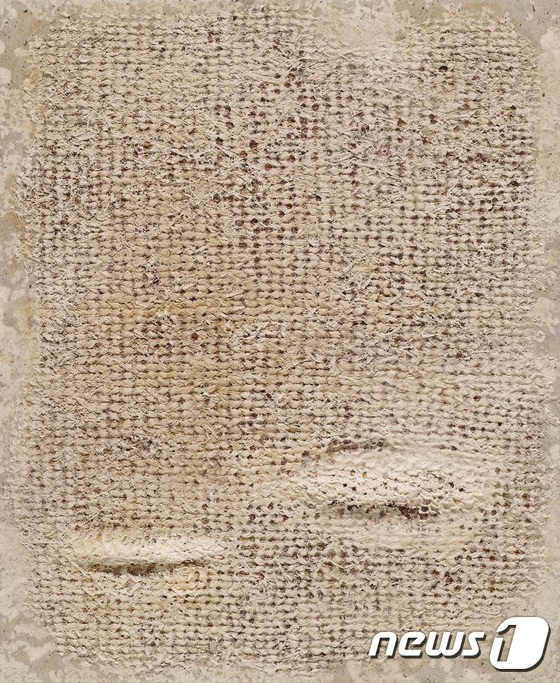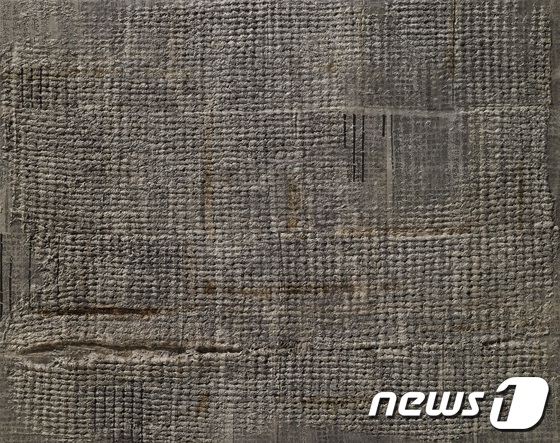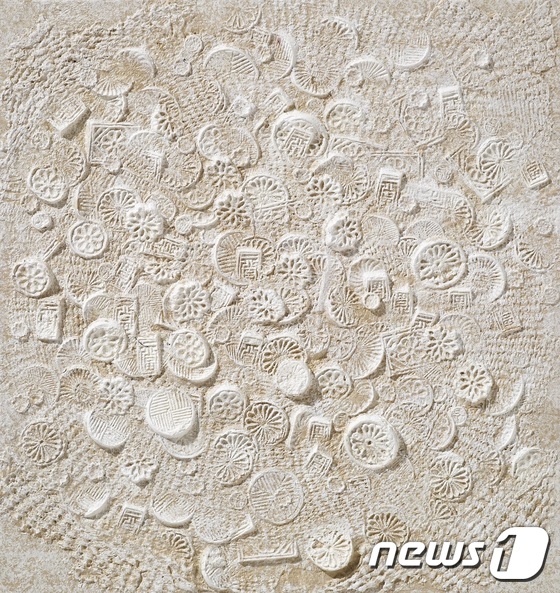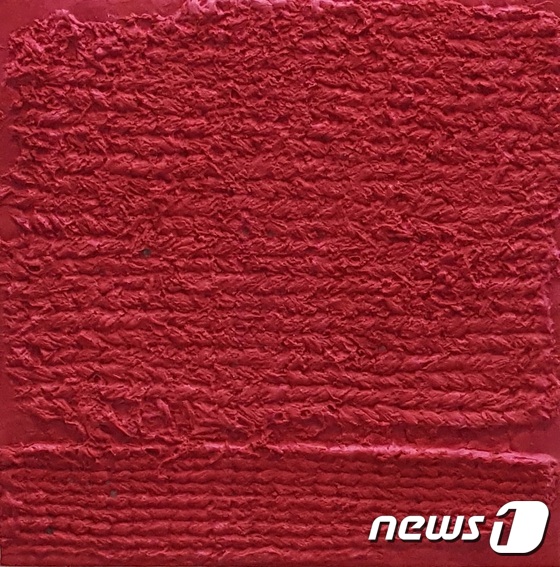캔버스는 오백년을 가고 한지는 천년을 간다 (서울=뉴스1) 2017-06-11
"캔버스는 오백년을 가고 한지는 천년을 간다"
박철 작가 "한지 부조작업 세계에 알리고파"
(서울=뉴스1) 김아미 기자 | 2017-06-11 12:03

Ensemble 16-1, 108x89cm, Korean Traditional paper, Natural dyes, 2016 (쥴리아나갤러리 제공) © News1
"'지천년견오백'(紙千年絹五百)이란 말이 있어요. 종이는 1000년 가고 캔버스는 500년 간다는 뜻이죠. 한지가 그만큼 보존성이 강하다는 겁니다."
서울 강남구 청담동 쥴리아나갤러리 개인전을 연 '한지 부조' 작가 박철 씨(홍익대학교 미술대학원 교수·67)가 최근 기자들과 만난 자리에서 전통 한지의 경쟁력에 대해 이같이 말했다. 그는 "한지는 수용적이고 수동적이라 작가가 얼마든지 변형해 무언가를 만들 수 있고, 순수하고 담백한 면은 한국적 정서와 가장 잘 맞닿아 있다"고 설명했다.
한지작가협회 초대회장이기도 한 박철 작가는 이번 개인전에서 '한지의 탐구 전통의 재창조'라는 주제로 신작을 선보였다. 1980년대 중반부터 한지 부조라는 독특한 작업 세계를 개척한 박 작가는 1990년 힐튼화랑에서 개인전을 시작으로 프랑스, 네덜란드, 캐나다 등 해외 갤러리에서 초대전을 열며 국내 대표적인 한지 작가로 이름을 알렸다.
한지를 이용한 대표적인 작가로는 박서보, 정창섭, 권영우, 전광영 등이 꼽힌다. 이 가운데 박철 작가는 한지에 자신만의 독특한 작업 방식을 더했다. 석고나 시멘트와 같은 경질의 재료로 몰딩을 만들고, 창틀이나 멍석, 바이올린을 올려 원하는 형태를 음각으로 떠낸 다음, 그 위에 한지나 색종이를 20~30여 회를 덧발라가며 양각의 형태를 얻어낸다. 특히 최근에는 전통기와의 파편, 문짝(창호), 멍석, 떡살 등 한국적인 소재를 '현대화'하는 작업에 집중하고 있다.

박철 작가. © News1
박철 작가는 "농촌에서 버려지거나 누추하고 보잘 것 없는 재료들을 현대적인 감각으로 다시 표현해 패션·디자인 1번지인 청담동에서 선보인다"며 "토속적이고 보잘것 없는 것이라도 그림의 테마가 될수 있다. 나아가 한국적인 것으로 세계 시장을 두드리고자 한다"고 말했다.
특히 멍석을 이용한 부조작업에 대해 "우리의 할아버지들이 일일이 손으로 만든 멍석을 캐스팅(주조)한 것"이라며 "이는 오늘날 한국 현대미술의 주류로 평가받는 '단색화'의 '반복의 확산'이라는 특징과도 연결된다"고도 했다.
그러면서 "멍석의 기능적 형태는 사라지고 텍스처(질감)와 색만 남는 추상적 결과물로 변모한다"며 "멍석이 무엇인지 모르는 외국 사람들이 보면 현대적인 추상화로 받아들인다"고 덧붙였다.
작가는 '장인정신'을 강조하기도 했다. "요즘 천경자·이우환 화백 하면 위작 시비부터 떠올리게 되지요. 저는 학생들에게 '위작 시비가 나도록 그림을 그리면 안 된다'고 이야기합니다. 그러면서 제 작품을 보여주고 말하죠. '한번 흉내내보라. 그대로 흉내내면 1000만원을 주겠다'고요. 작가의 작업에는 작가만의 노하우와 '미스터리'가 깃들어야 해요. 작가는 '장인정신'을 가져야 합니다."
이번 전시 서문을 쓴 서성록 미술평론가는 "근성 있는 '화공'(畵工)의 모습을 보는 것은 우리의 마음에 잔잔한 감동을 선사한다"며 "한지 탐구로 화업 30년을 장식한 그의 예술의 길은 오늘을 사는 우리에게 많은 것을 시사한다"고 평했다. 전시는 18일까지.

Ensemble 17-11, 85x108.5cm, Mixed media with Korean mulberry paper, 2017 (쥴리아나갤러리 제공) © News1

Fortune 15-2, 79x74cm, Korean Traditional Paper, Natural dyes, 2015 (쥴리아나갤러리 제공) © News1

Ensemble 17-33, 51x51cm, Mixed media with Korean paper, 2017 (쥴리아나갤러리 제공) © News1
“The canvas goes on five hundred years and Hanji(Korean traditional paper) goes hundred thousand years long.”
Park, Chul artist "Announcing the World of Hanji Relief Work"
"紙 千年 絹 五百, In this means that the Paper will last for 1000 years and the canvas will go for 500 years. Also Hanji(Korean traditional paper) strong enough to stay long and preserve ability of goods.
Park,Chul(Professor, University of Hongik, Graduate School of Fine Arts Department, 67), has sole exhibition in Julia gallery (Cheongdam-dong, Gangnam-gu, Seoul). Recently he said thus to the competitiveness of the traditional Korean paper which calls hanji after in a meeting with reporters. He explained that "Hanji is receptive and passive, so the artist can transform anything and make something, and the pure and simple aspects are the best in terms of Korean emotion,"
Park Chul, the first chairman of the Hanji Korean Artist Association, in this solo exhibition, the artist presented a new work under the theme of 'recreating the tradition of inquiry of Korean paper'. Since the mid-1980s, Park has pioneered the unique work world of Hanji relief priest. In 1990 he began to start solo exhibition at the Hilton Gallery after then he has been invited to exhibitions at overseas galleries in France, the Netherlands and Canada.
Typical artists using Hanji (Korean paper) include Park, Seo-bo, Jung, Chang-sup, Kwon, Young-woo, and Jeon,Gwang-young. Among them, Park Chulartist added his own style of unique works of Hanji. Molding is done with hard materials such as plaster and cement. And he produces a negative intaglio to the window frame and straw mat or violin shape. Then on top of that, it adds 20 ~ 30 coats of hanji and colored paper to get the shape of emboss. Especially recently, he concentrates on traditional Korean materials 'modernizing' such as fragments of traditional tiles, door (window), straw mat, and rice cake frame.
Park,chul artist said "I expresses modern materials, which are abandoned or burnt in the countryside, and which are insignificant material, I would like to show that even a local and subtle thing can be the theme of a painting, at Cheongdam-dong which is very fashionable and designable area. Furthermore, Korean way of style would be opening the world market.”
Especially, about the relief work is that "Our grandfathers cast by a hand.” And “In this is also connected to the characteristic of 'repetition of' monochromatic ', which is regarded as mainstream of contemporary Korean art today.” In the meantime, "the straw mat, it disappears functional form and texture (texture), it changes as an abstract objects remains.” And he also said that “For foreigners who do not know what straw mat is, it is accepted as a modern abstraction.”
The artist also emphasized 'craftsmanship'. These days, when the artists Cheong, yeong-ja and Lee, Woohwan’s work it reminds the forgery issues. I told the students "The forgery works should not happen”. Then I show my work and say it. 'Imitate it once. If someone exactly copy to work, I will give you 10 million won. The artist work must have to accumulate know-how and artist work should be having "mystery." The artist should have a ‘craftsmanship’.”
The preface to the exhibition, art critic Seo,seongrok, who wrote “ when look at the endurance artist it gives us a calm impression of our hearts.” And “The way of his art, this has been decorated with 30 years of artist way it regard to many things follow.”The exhibition shows until the 18th.